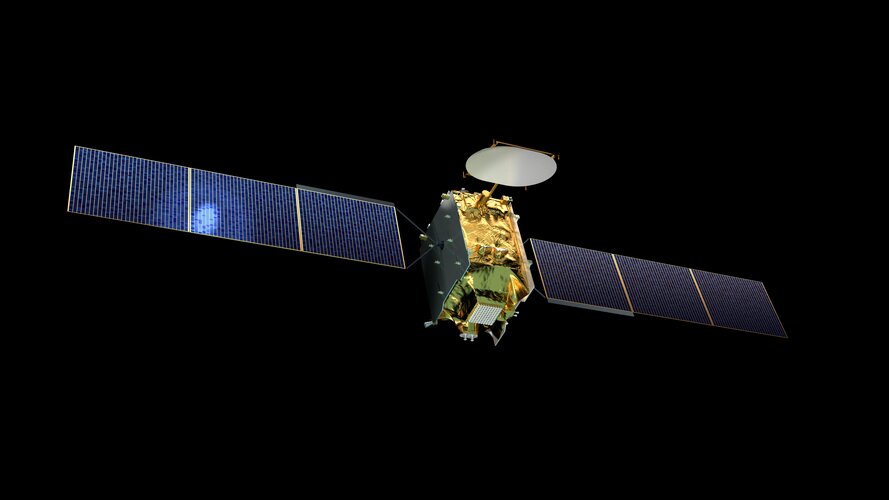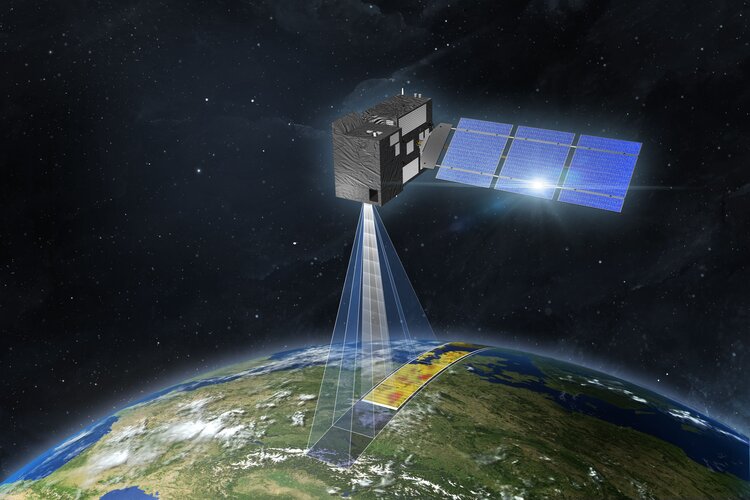
Copernical Team
Using blocks dropped from Perseverance and measured by InSight to learn more about Martian surface

An international team of space researchers has learned more about the density of the Martian surface by analyzing data from the Mars InSight lander that was received during Perseverance's descent. In their paper published in the journal Nature Astronomy, the group describes their study of seismic data from InSight as Perseverance dropped heavy blocks during its descent.
One of the ways that planetary scientists learn more about the makeup of other planets is by studying seismic activity—waves from such activity can provide clues to the density of different parts of a planet. In this new effort, the researchers noted that gathering seismic data from extraterrestrial events such as asteroids striking the surface of a planet is difficult as they are so random. But they also noted that the Perseverance mission offered a unique opportunity—as part of its descent earlier this year, the rover's landing craft dropped two tungsten blocks—each weighing approximately 77.5kg to the surface below.
Satellites for safer seas… and a safer world!
 Video:
00:02:43
Video:
00:02:43
What if the Titanic had help from satellites? Its journey would likely have ended completely differently.
We live in an ever-changing world; the shipping industry still faces the old dangers, but today also encounters risks due to climate change as well as incentives to become greener.
Fortunately ships today have satellite support. Satellites designed for science, weather monitoring, Earth observation, navigation and communication serve our security needs on a daily basis. Not only in the ocean, but worldwide, in any situation.
From fighting organised crime to monitoring climate change. From establishing worldwide food security to ensuring aviation safety. Global challenges
European software-defined satellite starts service

A telecommunications satellite that can be reprogrammed in-orbit, offering unprecedented mission reconfiguration capacity, has successfully passed its in-orbit acceptance review.
Carbon dioxide monitoring satellite given the shakes

A new satellite destined to be Europe’s prime mission for monitoring and tracking carbon dioxide emissions from human activity is being put through its paces at ESA’s Test Centre in the Netherlands. With nations at COP26 pledging net-zero emissions by 2050, the pressure is on to reduce the amount of greenhouse gases we pump into the atmosphere – but the race is also on to support the monitoring that shows targets are being met. ESA, the European Commission, Eumetsat and industrial partners are therefore working extremely hard to get the Copernicus Anthropogenic Carbon Dioxide Monitoring mission ready for liftoff
Astronaut training in the land of volcanoes

A team of astronauts, engineers and geologists is travelling to Spain’s Canary Islands, one of Europe’s volcanic hot spots, to learn how to best explore the Moon and Mars during ESA’s Pangaea geological training course.
Interview with Thomas Pesquet on return to Earth a second time
 Video:
00:04:56
Video:
00:04:56
ESA astronaut Thomas Pesquet gives a brief interview in Cologne, Germany, less than 48 hours after leaving the International Space Station.
He talks with ESA web TV editor Gaelle Lacroix in French and ESA editor Julien Harrod in English about returning to Earth after his six-month International Space Station mission Alpha, how it feels to splash down in a SpaceX Crew Dragon, and the differences with the Russian Soyuz spacecraft that flew him to space on his first mission, Proxima, in 2017.
After completing two six-month Space Station missions in five years, Thomas recounts the changes he saw while observing
NASA's big new moon rocket is stacked, awaiting launch
 NASA is nearing the final stages of rehearsal and checkouts of the Artemis I moon rocket - the first rocket of its kind since the Apollo program - before an uncrewed launch from Florida around the moon planned for early next year.
The 322-foot-tall SLS rocket and Orion capsule are completely assembled and stacked at Kennedy Space Center, a glowing orange and white tower reaching almos
NASA is nearing the final stages of rehearsal and checkouts of the Artemis I moon rocket - the first rocket of its kind since the Apollo program - before an uncrewed launch from Florida around the moon planned for early next year.
The 322-foot-tall SLS rocket and Orion capsule are completely assembled and stacked at Kennedy Space Center, a glowing orange and white tower reaching almos New agreement between Virgin Orbit and ANA Holdings sets the stage for 20 Launcherone flights from Japan
 Virgin Orbit, the responsive launch and space solutions company that has announced a planned business combination with NextGen Acquisition Corp. II, today announced that it has entered into a memorandum of understanding with ANA HOLDINGS INC., the owners of Japan's largest airline, to procure twenty flights of the LauncherOne rocket and to lead the effort to provide funds and support for those o
Virgin Orbit, the responsive launch and space solutions company that has announced a planned business combination with NextGen Acquisition Corp. II, today announced that it has entered into a memorandum of understanding with ANA HOLDINGS INC., the owners of Japan's largest airline, to procure twenty flights of the LauncherOne rocket and to lead the effort to provide funds and support for those o The Re-Emergence of China: The New Global Era
 The current narrative concerning China promulgated by the Western media and many political commentators is invariably hostile. This positioning is especially notable in the US and the UK. Whether out of a fixation with projecting power or motivated by ideological propaganda, this is a distorted perception.
While there are policy areas where, as with any country there is room for criticism
The current narrative concerning China promulgated by the Western media and many political commentators is invariably hostile. This positioning is especially notable in the US and the UK. Whether out of a fixation with projecting power or motivated by ideological propaganda, this is a distorted perception.
While there are policy areas where, as with any country there is room for criticism Crew Dragon Endeavour recovered after a successful splashdown
 The SpaceX Crew Dragon Endeavour spacecraft is lifted onto the GO Navigator recovery ship after it landed with NASA astronauts Shane Kimbrough and Megan McArthur, Japan Aerospace Exploration Agency (JAXA) astronaut Aki Hoshide, and ESA (European Space Agency) astronaut Thomas Pesquet in the Gulf of Mexico off the coast of Pensacola, Florida, Monday, Nov. 8, 2021. Kimbrough, McArthur, Hoshide, an
The SpaceX Crew Dragon Endeavour spacecraft is lifted onto the GO Navigator recovery ship after it landed with NASA astronauts Shane Kimbrough and Megan McArthur, Japan Aerospace Exploration Agency (JAXA) astronaut Aki Hoshide, and ESA (European Space Agency) astronaut Thomas Pesquet in the Gulf of Mexico off the coast of Pensacola, Florida, Monday, Nov. 8, 2021. Kimbrough, McArthur, Hoshide, an 